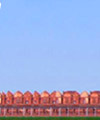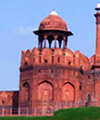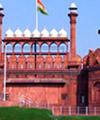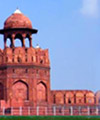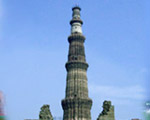|
Excursion
Delhi offers plethora of tourist places and attractions giving
a wide scope to the travelers to explore Delhi. Whereas the Old
Delhi boasts of Delhi as a Muslim reign with attractions like mosques,
forts, and other monuments; the New Delhi with its modern buildings,
shopper's stops and multiplexes depict Delhi as the modern political
and cultural capital of India. The tourist places in Old Delhi include
the majestic Red Fort, the historical Chandni Chowk, besides Raj
Ghat and Shanti Vana, the last two being modern structures constructed
after India's Independence in 1947. New Delhi is a modern city designed
by Edwin Lutyens and Herbert Baker. Major attractions in New Delhi
include the Rashtrapati Bhawan, the one-time imperial residence
of the British viceroys; the India Gate, a memorial raised in honour
of the Indian soldiers martyred during the Afghan war; the Laxminarayan
Temple, built by the Birlas, one of India's leading industrial houses;
the Humayun's Tomb, said to be the forerunner of the Taj at Agra;
the Purana Quila, built by Humayun, with modifications done by Sher
Shah Suri; Tughlaqabad, Delhi's most colossal and awesome fort;
Qutub Minar, built by Qutub-ud-din Aibek of the Slave Dynasty; and
the lotus-shaped Bahai Temple.
Rashtrapati
Bhawan
Architecturally an impressive building, Rashtrapati Bhawan stands
at a height competitive to the India Gate. This stretch is called
the Rajpath where the Republic Day parade is held. Perfectly designed
by Edwin Lutyens, its charisma does not fade away whether in summer
or winter.
India Gate
India Gate is a memorial raised in honour of the Indian soldiers
martyred during the Afghan war. The green, velvety lawns at India
Gate, particularly, offer a popular evening and holiday rendezvous
for young and old alike.
Laxminarayan Temple
Popular as the Birla Mandir, the Laxminarayan Temple was built by
the Birla family in 1938, encompassed by a large garden and fountains
behind it. The temple attracts thousands of devotees on Janmashtami
day, the birthday of Lord Krishna. The Father of the Nation, Mahatma
Gandhi, was assassinated in this temple complex in 1948.
Humayun's Tomb
Humayun's Tomb was built in 1565, nine years after Humayun's death
by his wife Haji Begum. Designed by a Persian architect named Mirak
Mirza Ghiyas, the edifice was a trendsetter of the time. It is believed
that all later Mughal monuments, including the Taj Mahal, followed
the suite.
Qutub
Minar
Located at a small village called Mehrauli in South Delhi, it was
built by Qutub-ud-din Aibek of the Slave Dynasty, the ruler of Delhi
in 1206. A fluted 72.5 metres red sandstone tower is covered with
intricate carvings and verses from the holy Qur'an. Qutub-ud-din
Aibak began the construction of this victory tower as a sign of
Muslim domination of Delhi to call the faithful to prayer. However,
only the first storey was completed by Qutb-ud-din. The other storeys
were built by his successor Iltutmish. The two circular storeys
in white marble were built by Ferozshah Tughlaq in 1368, replacing
the original fourth storey.
The projected balconies in the tower are engraved by exquisite
stalactite designs. The bands of calligraphic inscriptions are amazing
in perfection with the exquisite stalactite designs seen on the
exterior of this tower.
The Qutub Minar is a historical landmark as it is the first monument
of Muslim rule in India, also the edifice pioneering the Indo-Islamic
architecture in India.
Red Fort
The Old Delhi projects an image just contrast to the one projected
by New Delhi. Undoubtedly, Old Delhi gives an insight into the multifarious
culture that aptly characterizes India. Narrow and overcrowded lanes,
yet throbbing with life may be repulsive for you. Contrary to this,
is the undying attraction of Red Fort that captures your attention.
Made in 1639, when Shahjahan decided to shift his capital to Delhi.
Within eight years, Shahjahanabad was completed with the Red Fort-Quila-i-Mubarak
(fortunate citadel)-Delhi's seventh fort.
Chandni Chowk
The living legacy of Delhi is Shahjahanabad. Created by Shahjahan,
this city, with the Red Fort and Jama Masjid as the principal landmarks,
has a fascinating market planned to shine under the light of the
moon, called Chandni Chowk. Shahjahan planned Chandni Chowk market
for his daughter. Divided by canals filled with water, this place
glistened like silver in the moonlight. The canals are now closed,
but Chandni Chowk remains Asia's largest wholesale market till date.
Crafts once patronized by the Mughals continue to flourish in the
small lanes of the city. An experience of timelessness awaits you
at Shahjahanabad.
Raj
Ghat
On the bank of the legendary Yamuna, there is Raj Ghat-the last
resting place of Mahatma Gandhi, the father of the nation. It has
become an essential point of call for all visiting dignitaries.
Two museums dedicated to Gandhiji are situated nearby.
Shanti Vana
Beside the Raj Ghat lies the Shanti Vana (literally, the forest
of peace), the place where India's first Prime Minister Jawaharlal
Nehru was cremated. The area is now a beautiful park adorned by
trees planted by visiting dignitaries and heads of state.
Bahai Temple (Lotus Temple)
The Bahai Temple, situated in South Delhi resembles a lotus. It
is an eye-catching edifice worth exploring dedicated to Bahai community.
It offers the visitor a serenity that pervades the temple and its
artistic design.
Purana Quila
The Purana Quila is a fort signifying the medieval military architecture.
Built by Humayun, with later-day modifications by Sher Shah Suri,
the Purana Quila is a fortress of bold design. Purana Quila is also
different from the other forts of the Mughals, as it does not have
a complex of palaces, administrative and recreational buildings,
as is generally found in the forts built later on. The main purpose
of this fort was its utility rather than decoration.
The Qal'a-I-Kunha Masjid and the Sher Mandal are two important
monuments inside the fort.
Tughlaqabad
Ghazi Malik built the strongest fort in Delhi at Tughlaqabad, when
he founded the Tughlaq Dynasty in 1321. He completed it within four
years of his rule. It is said that Ghazi Malik, when only a slave
to Mubarak Khilji, had suggested this rocky prominence as an ideal
site for a fort. The Khilji Sultan laughed and suggested that the
slave build a fort there when he became a Sultan. Ghazi Malik as
Ghiyasuddin Tughlaq did just that-Tughlaqabad is Delhi's most colossal
and awesome fort, even in its ruined state. Within its sky-touching
walls, double-storied bastions, and gigantic towers were housed
grand palaces, splendid mosques, and audience halls.
Top
Information on Tours & Travel excursion of Delhi - India
| 

